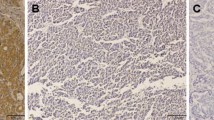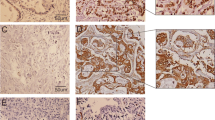Abstract
Purpose
To examine expression profile and prognostic significance of vascular endothelial growth factor (VEGF) and its receptors in hepatocellular carcinoma (HCC) and peritumoral tissue.
Methods
Expression of VEGF-A, VEGF-C, and VEGF receptor 1(VEGFR-1), VEGFR-2, and VEGFR-3 in tumor and peritumoral liver tissue was studied by immunohistochemistry in a tissue microarray from 107 patients with HCC. Unsupervised hierarchical cluster analyses were conducted to identify relevant clusters.
Results
Staining of VEGF-A, VEGF-C, VEGFR-2, and VEGFR-3 was mostly found on the tumor cells and peritumoral hepatocytes, but VEGFR-1 was mostly expressed in stromal cells. In most of the cases, the expression of VEGF-A, VEGFR-1, VEGFR-2, and VEGFR-3 in was higher in peritumoral liver tissue, while VEGF-C expression was higher in tumor. Unsupervised hierarchical clustering analysis identified four prognostically different clusters, of which cluster A was classified into the “poor prognosis group,” and the other three clusters were classified into the “good prognosis group” (P = 0.047). Further analysis with a set of seven markers reproduced the same four cluster groups with significantly different recurrence free probability (RFP) (P = 0.018), and the low RFP group was associated with more intrahepatic satellite lesions. Multivariate analysis showed that classification defined by seven biomarkers was of prognostic significance (P = 0.000).
Conclusions
Expression of VEGF and its receptors was higher in peritumoral tissue than in tumor in HCC. Seven biomarkers predicted patients’ RFP, which consisted of tumoral expression of VEGF-A, VEGFR-1, and VEGF-C as well as peritumoral expression of VEGF-A, VEGFR-1, VEGFR-2, and VEGFR-3.



Similar content being viewed by others
References
Alizadeh AA, Ross DT, Perou CM, van de Rijn M (2001) Towards a novel classification of human malignancies based on gene expression patterns. J Pathol 195:41–52. doi:10.1002/path.889
Au NH, Cheang M, Huntsman DG et al (2004) Evaluation of immunohistochemical markers in non-small cell lung cancer by unsupervised hierarchical clustering analysis: a tissue microarray study of 284 cases and 18 markers. J Pathol 204:101–109. doi:10.1002/path.1612
Budhu A, Forgues M, Ye QH et al (2006) Prediction of venous metastases, recurrence, and prognosis in hepatocellular carcinoma based on a unique immune response signature of the liver microenvironment. Cancer Cell 10:99–111. doi:10.1016/j.ccr.2006.06.016
Calvisi DF, Ladu S, Gorden A et al (2006) Ubiquitous activation of Ras and Jak/Stat pathways in human HCC. Gastroenterology 130:1117–1128. doi:10.1053/j.gastro.2006.01.006
El-Assal ON, Yamanoi A, Soda Y et al (1998) Clinical significance of microvessel density and vascular endothelial growth factor expression in hepatocellular carcinoma and surrounding liver: possible involvement of vascular endothelial growth factor in the angiogenesis of cirrhotic liver. Hepatology 27:1554–1562. doi:10.1002/hep.510270613
Hicklin DJ, Ellis LM (2005) Role of the vascular endothelial growth factor pathway in tumor growth and angiogenesis. J Clin Oncol 23:1011–1027. doi:10.1200/JCO.2005.06.081
Hussain SP, Schwank J, Staib F et al (2007) TP53 mutations and hepatocellular carcinoma: insights into the etiology and pathogenesis of liver cancer. Oncogene 26:2166–2176. doi:10.1038/sj.onc.1210279
Jacquemier J, Ginestier C, Rougemont J et al (2005) Protein expression profiling identifies subclasses of breast cancer and predicts prognosis. Cancer Res 65:767–779
Kaipainen A, Korhonen J, Mustonen T et al (1995) Expression of the fms-like tyrosine kinase 4 gene becomes restricted to lymphatic endothelium during development. Proc Natl Acad Sci USA 92:3566–3570. doi:10.1073/pnas.92.8.3566
Kajita T, Ohta Y, Kimura K et al (2001) The expression of vascular endothelial growth factor C and its receptors in non-small cell lung cancer. Br J Cancer 85:255–260. doi:10.1054/bjoc.2001.1882
Kaposi-Novak P, Lee JS, Gomez-Quiroz L et al (2006) Met-regulated expression signature defines a subset of human hepatocellular carcinomas with poor prognosis and aggressive phenotype. J Clin Invest 116:1582–1595. doi:10.1172/JCI27236
Lee HS, Cho SB, Lee HE et al (2007) Protein expression profiling and molecular classification of gastric cancer by the tissue array method. Clin Cancer Res 13:4154–4163. doi:10.1158/1078-0432.CCR-07-0173
Li XM, Tang ZY, Qin LX et al (1999) Serum vascular endothelial growth factor is a predictor of invasion and metastasis in hepatocellular carcinoma. J Exp Clin Cancer Res 18:511–517
Llovet JM, Burroughs A, Bruix J (2003) Hepatocellular carcinoma. Lancet 362:1907–1917. doi:10.1016/S0140-6736(03)14964-1
Makretsov NA, Huntsman DG, Nielsen TO et al (2004) Hierarchical clustering analysis of tissue microarray immunostaining data identifies prognostically significant groups of breast carcinoma. Clin Cancer Res 10:6143–6151. doi:10.1158/1078-0432.CCR-04-0429
Otrock ZK, Makarem JA, Shamseddine AI (2007) Vascular endothelial growth factor family of ligands and receptors. Blood Cells Mol Dis 38:258–268. doi:10.1016/j.bcmd.2006.12.003 review
Parkin DM (2001) Global cancer statistics in the year 2000. Lancet Oncol 2:533–543. doi:10.1016/S1470-2045(01)00486-7
Poon RT, Ng IO, Lau C et al (2002) Tumor microvessel density as a predictor of recurrence after resection of hepatocellular carcinoma: a prospective study. J Clin Oncol 20:1775–1785. doi:10.1200/JCO.2002.07.089
Price DJ, Miralem T, Jiang S et al (2001) Role of vascular endothelial growth factor in the stimulation of cellular invasion and signaling of breast cancer cells. Cell Growth Differ 12:129–135
Sun HC, Tang ZY, Li XM et al (1999) Microvessel density of hepatocellular carcinoma: its relationship with prognosis. J Cancer Res Clin Oncol 125:419–426. doi:10.1007/s004320050296
Suzuki K, Hayashi N, Miyamoto Y et al (1996) Expression of vascular permeability factor/vascular endothelial growth factor in human hepatocellular carcinoma. Cancer Res 56:3004–3009
Tang ZY, Ye SL, Liu YK et al (2004) A decade’s studies on metastasis of hepatocellular carcinoma. J Cancer Res Clin Oncol 130:187–196. doi:10.1007/s00432-003-0511-1
Toi M, Bando H, Ogawa T et al (2002) Significance of vascular endothelial growth factor (VEGF)/soluble VEGF receptor-1 relationship in breast cancer. Int J Cancer 98:14–18. doi:10.1002/ijc.10121
von Marschall Z, Cramer T, Hocker M et al (2001) Dual mechanism of vascular endothelial growth factor upregulation by hypoxia in human hepatocellular carcinoma. Gut 48:87–96. doi:10.1136/gut.48.1.87
Yamaguchi R, Yano H, Iemura A et al (1998) Expression of vascular endothelial growth factor in human hepatocellular carcinoma. Hepatology 28:68–77. doi:10.1002/hep.510280111
Yamaguchi R, Yano H, Nakashima Y et al (2000) Expression and localization of vascular endothelial growth factor receptors in human hepatocellular carcinoma and non-HCC tissues. Oncol Rep 7:725–729
Yu GR, Kim SH, Park SH et al (2007a) Identification of molecular markers for the oncogenic differentiation of hepatocellular carcinoma. Exp Mol Med 39:641–652
Yu D, Zhuang L, Sun X et al (2007b) Particular distribution and expression pattern of endoglin (CD105) in the liver of patients with hepatocellular carcinoma. BMC Cancer 7:122. doi:10.1186/1471-2407-7-122
Zhu XD, Zhang JB, Zhuang PY et al (2008) High expression of macrophage colony-stimulating factor in peritumoral liver tissue associated with poor survival after curative resection of hepatocellular carcinoma. J Clin Oncol 26:2707–2716. doi:10.1200/JCO.2007.15.6521
Author information
Authors and Affiliations
Corresponding author
Additional information
J.-B. Jia and P.-Y. Zhuang contributed equally to this work.
Rights and permissions
About this article
Cite this article
Jia, JB., Zhuang, PY., Sun, HC. et al. Protein expression profiling of vascular endothelial growth factor and its receptors identifies subclasses of hepatocellular carcinoma and predicts survival. J Cancer Res Clin Oncol 135, 847–854 (2009). https://doi.org/10.1007/s00432-008-0521-0
Received:
Accepted:
Published:
Issue Date:
DOI: https://doi.org/10.1007/s00432-008-0521-0




